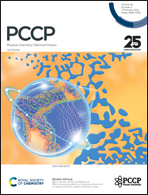Site specifically probing the unfolding process of human telomere i-motif DNA using vibrationally enhanced alkynyl stretch†
Abstract
The microscopic unfolding process of a cytosine-rich DNA forming i-motif by hemi-protonated base pairs is related to gene regulation. However, the detailed thermal unfolding mechanism and the protonation/deprotonation status of site-specific cytosine in DNA in a physiological environment are still obscure. To address this issue, a vibration-enhanced C![[triple bond, length as m-dash]](https://www.rsc.org/images/entities/char_e002.gif) C probe tagged on 5′E terminal cytosine of human telomere i-motif DNA was examined using linear and nonlinear infrared (IR) spectroscopies and quantum-chemistry calculations. The C
C probe tagged on 5′E terminal cytosine of human telomere i-motif DNA was examined using linear and nonlinear infrared (IR) spectroscopies and quantum-chemistry calculations. The C![[triple bond, length as m-dash]](https://www.rsc.org/images/entities/char_e002.gif) C probe extended into the major groove of the i-motif was found using nonlinear IR results only to introduce a minor steric effect on both steady-state structure and local structure dynamics; however, its IR absorption profile effectively reports the cleavage of the hemi-protonated base pair of C1–C13 upon the unfolding with C1 remaining protonated. The temperature mid-point (Tm) of the local transition reported using the C
C probe extended into the major groove of the i-motif was found using nonlinear IR results only to introduce a minor steric effect on both steady-state structure and local structure dynamics; however, its IR absorption profile effectively reports the cleavage of the hemi-protonated base pair of C1–C13 upon the unfolding with C1 remaining protonated. The temperature mid-point (Tm) of the local transition reported using the C![[triple bond, length as m-dash]](https://www.rsc.org/images/entities/char_e002.gif) C tag was slightly lower than the Tm of global transition, and the enthalpy of the former exceeds 60% of the global transition. It is shown that the base-pair unraveling is noncooperative, with outer base pairs breaking first and being likely the rate limiting step. Our results offered an in-depth understanding of the macroscopic unfolding characteristics of the i-motif DNA and provided a nonlinear IR approach to monitoring the local structural transition and dynamics of DNA and its complexes.
C tag was slightly lower than the Tm of global transition, and the enthalpy of the former exceeds 60% of the global transition. It is shown that the base-pair unraveling is noncooperative, with outer base pairs breaking first and being likely the rate limiting step. Our results offered an in-depth understanding of the macroscopic unfolding characteristics of the i-motif DNA and provided a nonlinear IR approach to monitoring the local structural transition and dynamics of DNA and its complexes.

- This article is part of the themed collection: 2024 PCCP HOT Articles


 Please wait while we load your content...
Please wait while we load your content...